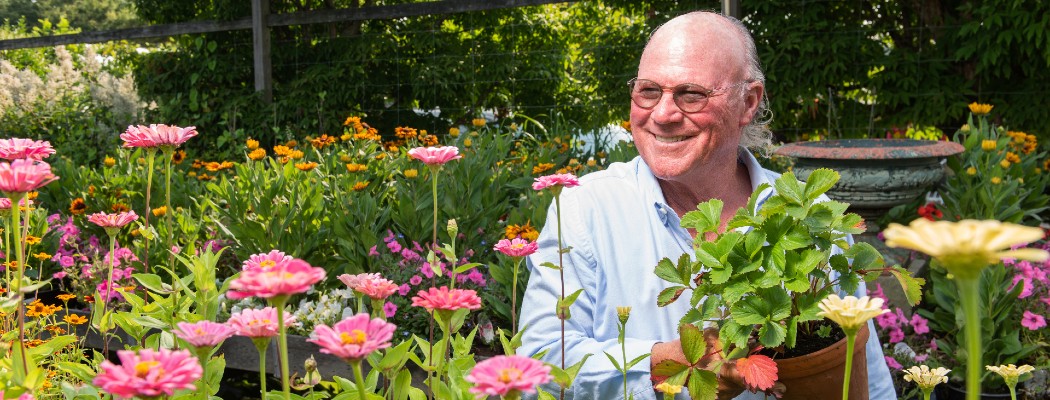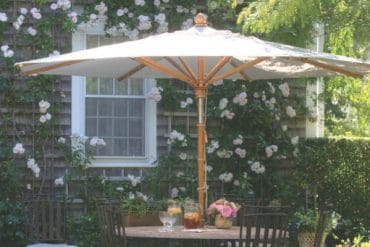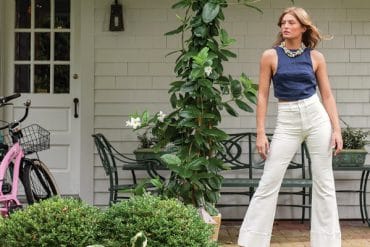Digging into the creative genius of Pumpkin Pond Farm’s Marty McGowan.
Marty McGowan reminds us how essential true Nantucket characters are to the soul of the community. A self-described “spirit gardener” and master horticulturist turned shaman, storyteller and muse, McGowan harks back to the old days on Nantucket when the word “wart” referred to the often haphazard addition of an extra room onto an existing ’Sconset cottage. “I am responsible for adorning many, many warts with many, many roses,” McGowan says. “I am joyful for my life on Nantucket. I feel that I’ve been very lucky to serve the island.”
As the owner of Pumpkin Pond Farm, McGowan is well known for his enormous success as a landscape architect, master gardener and organic farmer. Considered by some to be a tough boss, he thinks of himself “more as a teacher.” But spend an afternoon with McGowan in his office on Somerset Road or his farm on Millbrook Road and you’ll find yourself in the presence of a true creative, an artist whose masterpieces are made not with paint and pallet, but with plow and petals. “The gardener is also the outdoor maid,” McGowan says, sitting behind his desk. “I am the person who mows your lawn, who keeps it clean, sweeps your sidewalk, brushes off your deck, tends to your flowers.”
An aesthetic gestalt, McGowan’s office is a direct reflection of the life and mind of its chief inhabitant, a skillful scavenger of the very best of flea markets from Paris to Istanbul. “One of my clients told me that my office looks like a brothel,” he jokes, a good-natured grin spreading across his wind- and sunburned face. Like Indiana Jones’ professorial digs, every artifact in McGowan’s space tells a story, and the spirit gardener is happy to indulge those who are curious. This is the working laboratory of a true tastemaker—a space where old-world luxury collides with the working reality of Nantucket’s signature heritage landscape design firm.

The specs for Pumpkin Pond Farm, McGowan’s vision of sustainable agriculture on Nantucket, were inspired in part by the cubist “strata” of abstract artist Paul Klee’s famous 1929 painting Highways and Byways. He confesses that while designing and implementing the structural layout of Pumpkin Pond Farm, he “nearly drove the staff crazy” with his exacting specifications.
For McGowan, the creation of a garden for another person is the creation of happiness through the recognition and cultivation of spirit. “What I try to do is discover what your spirit is, interpret that and create a garden that is truly you,” he explains. “The spirit is yours; mine is the interpretation of spirit.”
And how exactly is this done? “Here’s a scenario,” he says. “I go to a client’s house, and I talk to them about who they are. One—what is your favorite color?” Blue. “Blue—excellent. If I am building a blue garden for you, I would ask you, do you like to sing the blues? What is it about blue that you like? I ask a client to give me their colors. Some of them have them, some of them don’t.” McGowan points to a color palette on a client portfolio—a range of oranges, grays, taupes and “salty, French blues.” Beneath the color palette are the words “simple, honest, tough.” “These colors say, ‘I am a simple person. I don’t need a lot. I am honest. I respect honesty and I don’t lie. I am tough—I will fight for what I believe in.’ The oranges are the toughness. It takes a pumpkin four months to grow, whatever happens—bugs, water, no water. Then there is Mexican feather grass—wild, free, simple. Nothing fussy about it. Honest—here is a little bath stone where you can rinse your feet off after you go to the beach. You need that sort of vernacular to create a garden.”
McGowan’s exquisite flower selection distinguishes his gardens around the island. He employs such rare breeds as the “Do Tell” peony, an extremely large Chinese peony he gets from an exclusive breeder. “The peony is ‘the king’ of the garden,” explains McGowan, indicating the spread of an eight-to-nine-inch bloom with his massive, strong hands, which seem to be permanently etched with fine lines of dirt. “It’s a monster, and when it blooms, you stop your car. It’s very difficult to get. But in reality, this plant is nothing but a bunch of leaves. It blooms like this for about three weeks out of an entire year, so when I buy my peonies, the quality of the leaf is more important to me than the quality of the flower.”
McGowan describes the importance of timing, of “the curated transition” of a garden. When his clients come in June, for instance, their peonies are blooming. When they return in late July, they may find his particular favorite breed of salmon-colored poppies peeking up through a sea of green peony leaves. “I love poppies—but what I really love, why I really grow poppies, are for their seed pods. Some of them are humongous, and when they dry out, they leave a skeleton full of seeds. There is so much more to the seed pod than the flower. The flower comes and goes, but the seed pod is there for months.”
In this unexpected appreciation for the anti-bloom—the leaves left after the blossoming, the skeletal seed pod that remains after the colorful poppy flower wilts, McGowan finds his concept for the “spirit garden.” He interprets the spirit of various plants and how that plant spirit complements the spirit of the human for whom he is designing and building the garden. “A spirit garden contains the spirit of the place,” he says. “Plants have spirit. You see the spirit, and you conjure the spirit. The spirit is also ephemeral. There are moments that create real emotional content in the person.”
McGowan considers his own garden an analogy of his psycho-spiritual development. “My spirit garden is an evolvement in education,” he says. “My garden is forever growing, changing and modifying itself. It can many times recreate itself spotlessly. I can use the exact same plant collection year after year after year after year. It’s ‘the right collection’ for the spot. The plants are successful and happy there. I have no interest in making my garden common.”
He takes an ultra-thin folding knife with a three-inch blade out of his pocket and unwraps a new book of impressionist garden paintings. He opens to the centerfold and points to a scene full of flowers by Gustav Klimt. “But I get paid for bloom. That Klimt—that’s about bloom. No matter how many dots or how many blossoms or how many blooms are in that painting, it’s about the rhythm that your eye dances while you are looking into it. I could make you a garden that reminded you of the repeat in your life, because when a great garden is made, many things are repeated. Things that are well-chosen, things that are right for a spot—they are happy there.”








